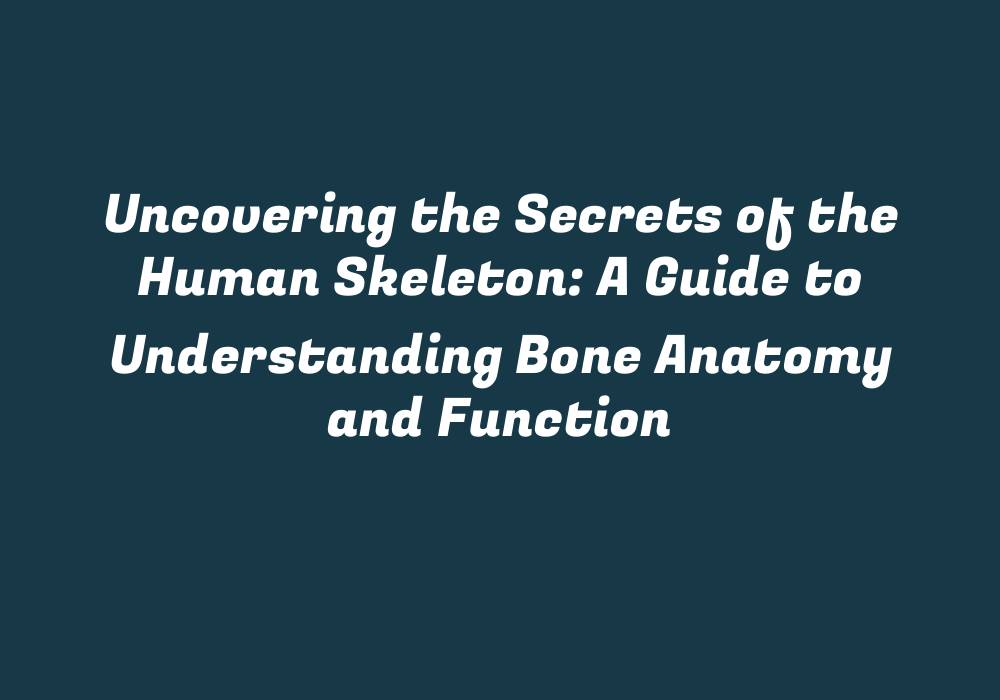Introduction to the Human Skeleton
The human skeletal system is one of the most critical components of our body, providing support and structure for various essential functions. In this article, we will explore the secrets of the human skeleton by delving into its anatomy, function, and significance. By understanding the complexity of bones and their interconnected relationships, we can appreciate better how these elements contribute to our overall health and well-being.
Bone Anatomy
Types: The human skeleton consists primarily of two types of bones: axial and appendicular. Axial bones, which include the skull, vertebrae, ribs, and parts of the pelvis, provide structural support for the body’s core. Appendicular bones are the limbs’ bones (humerus, femur, etc.) and contribute to locomotion and manipulation.
Bone Structure: Bones have a complex structure, comprising several layers. The outermost layer is compact bone, made up of dense, hard tissue that provides strength and protection for the underlying bone marrow cavity. Next comes the spongy bone or trabecular bone, a lattice-like network of thin rods and plates that offer flexibility and weight reduction while maintaining structural integrity. Lastly, the medullary cavity houses red bone marrow responsible for producing blood cells.
Bone Function
Support and Protection: The primary function of bones is to provide support and protection for the body’s vital organs. This role allows us to move around freely, maintain an upright posture, and absorb impacts from everyday activities. Bones also protect and house several vital organs, such as the heart within the ribcage.
Mineralization and Storage: The human skeleton is constantly renewing itself through a process known as remodeling. Old bone tissue is broken down and replaced by new bone matter at varying rates, depending on the specific part of the body. This ongoing process contributes to mineral storage and ensures bones remain healthy and strong. Bone marrow also plays a crucial role in producing red blood cells that carry oxygen throughout the body.
Movement: The appendicular skeleton enables movement by supporting our limbs, joints, and muscles. Muscles are attached to bones via tendons, creating levers that allow for various types of motion. As we engage in different activities, our bones experience stress, which stimulates the bone-remodeling process and promotes overall bone health.
Bone Anatomy and Function: Interconnected Relationships
Articulations: Bones are connected to one another via joints, creating a complex system of levers that allows for various types of motion. The movements at these joints are controlled by ligaments, which connect bones and provide support, as well as tendons, which attach muscles to bones.
Blood Flow: Bones house the spongy bone marrow, where red blood cells are produced. These cells transport oxygen throughout the body, supporting various physiological functions and helping maintain homeostasis. The flow of blood is essential for maintaining a healthy skeletal system.
Muscle Attachments: Bones work in tandem with muscles to create complex movements that allow us to perform everyday tasks and engage in physical activities. The arrangement and connection of muscles, tendons, ligaments, and bones form intricate biomechanical systems responsible for our movement capabilities.
Conclusion
Understanding the human skeleton’s anatomy and function provides us with a deeper appreciation for its significance in maintaining overall health and well-being. Bone remodeling, mineralization, and various structural support mechanisms work together to ensure our bodies remain strong, flexible, and adaptable to the challenges of daily life. By fostering awareness and proper care for our skeletal system, we can better protect and enhance the body’s ability to support its many essential functions.
Further Reading and Resources
Bone Anatomy, Remodeling, and Mechanobiology – A scientific article discussing bone structure, remodeling, and the relationship between biomechanics and bone health.
How Muscles, Tendons, and Ligaments Work Together – A comprehensive guide from the National Health Service (NHS) exploring how these tissue types interact to support human movement.
Muscles and Bones – A resource from the National Institute of Arthritis and Musculoskeletal and Skin Diseases offering information on the role of muscles, tendons, ligaments, and bones in maintaining human movement.
Bone Health – A guide from the National Institute of Arthritis and Musculoskeletal and Skin Diseases addressing common bone health concerns, tips for maintaining healthy bones, and related resources.
